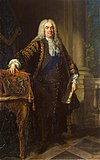Francis Godolphin, 2nd Earl of Godolphin
William III, Anne | |
|---|---|
| Preceded by | Henry Carew |
| Succeeded by | Thomas Coke |
| Personal details | |
| Born | 3 September 1678 Whitehall, London, England |
| Died | 17 January 1766 (aged 87) |
| Spouse | |
| Children |
|
| Parents | |
| Alma mater | Eton College King's College, Cambridge (M.A., 1705) |
Francis Godolphin, 2nd Earl of Godolphin,
Early life
Godolphin, the only child of Sidney Godolphin, 1st Earl of Godolphin, was born in Whitehall, London, on 3 September 1678, and baptised the same day. His mother, Margaret Godolphin (née Blagge), died six days later on 9 September. John Evelyn, who had been her most intimate acquaintance, transferred his friendship to her infant son, took general charge of his education, and continued to further his welfare as he grew. Godolphin was educated at Eton College, and at King's College, Cambridge, where he took an M.A. degree in 1705.[1]
Career
Godolphin was returned as
Godolphin was known by the courtesy title of Viscount Rialton from 29 December 1706 until 1712. Early in 1708, he gave up the office of Warden of the Stannaries, and the other posts which had become too burdensome for him. At the 1708 British general election, he was returned as MP for both Helston and Oxfordshire and chose to sit at Oxfordshire. In 1710 he voted for the impeachment of Dr Henry Sacheverell. At the 1710 British general election he chose not to stand at Oxfordshire, was defeated at Penryn, but was returned as MP for Tregony on the Boscawen interest. He was classed as a Whig and lost his post in the Household on the change of Administration. He voted for the ‘No Peace Without Spain’ motion on 7 December 1711. On his father's death on 15 September 1712, he succeeded to the peerage as Earl of Godolphin. He vacated his seat in the House of Commons and joined the House of Lords.[2]
Lord Rialton was again Cofferer of the Household from 1714 to 1723, as well as
On 23 January 1735, Lord Rialton was created
Godolphin was married in March 1698 to
Godolphin was one of the founding governors of the
Death and legacy
Lord Godolphin died at his house in the Stable Yard, St James's, on 17 January 1766 and was buried in Kensington Church on 25 January. He and his wife had two sons and four daughters, of whom two sons and a daughter predeceased him.
- William Godolphin, Marquess of Blandford (c. 1699–1731), who married Maria Catherina de Jong
- Lord Henry Godolphin (born February 1701)
- Lady Margaret Godolphin (born c. 1703)
- 1st Duke of Newcastle
- Lady Mary Godolphin (1723–1764), who married the 4th Duke of Leeds.
Without living male heirs, the earldom of Godolphin, viscountcy of Rialton and barony of Godolphin of Rialton became extinct. The last devolved on his cousin Francis Godolphin, 2nd Baron Godolphin of Helston.[4]
Notes
- ^ "Godolphin, Francis (GDLN695F)". A Cambridge Alumni Database. University of Cambridge.
- ^ a b c "GODOLPHIN, Hon. Francis (1678-1766)". History of Parliament Online. Retrieved 2 July 2019.
- ^ a b Stephen, Leslie; Lee, Sidney, eds. (1890). . Dictionary of National Biography. Vol. 22. London: Smith, Elder & Co.
- ^ "London, Saturday January 18". Salisbury and Winchester Journal. 20 January 1766. Retrieved 17 January 2016.
References
- Nichols and, R. H.; Wray, F. A. (1935). The History of the Foundling Hospital. London: Oxford University Press. p. 345.
- Attribution
![]() This article incorporates text from a publication now in the public domain: Boase, George Clement (1890). "Godolphin, Francis". In Stephen, Leslie; Lee, Sidney (eds.). Dictionary of National Biography. Vol. 22. London: Smith, Elder & Co. pp. 39–40.
This article incorporates text from a publication now in the public domain: Boase, George Clement (1890). "Godolphin, Francis". In Stephen, Leslie; Lee, Sidney (eds.). Dictionary of National Biography. Vol. 22. London: Smith, Elder & Co. pp. 39–40.

